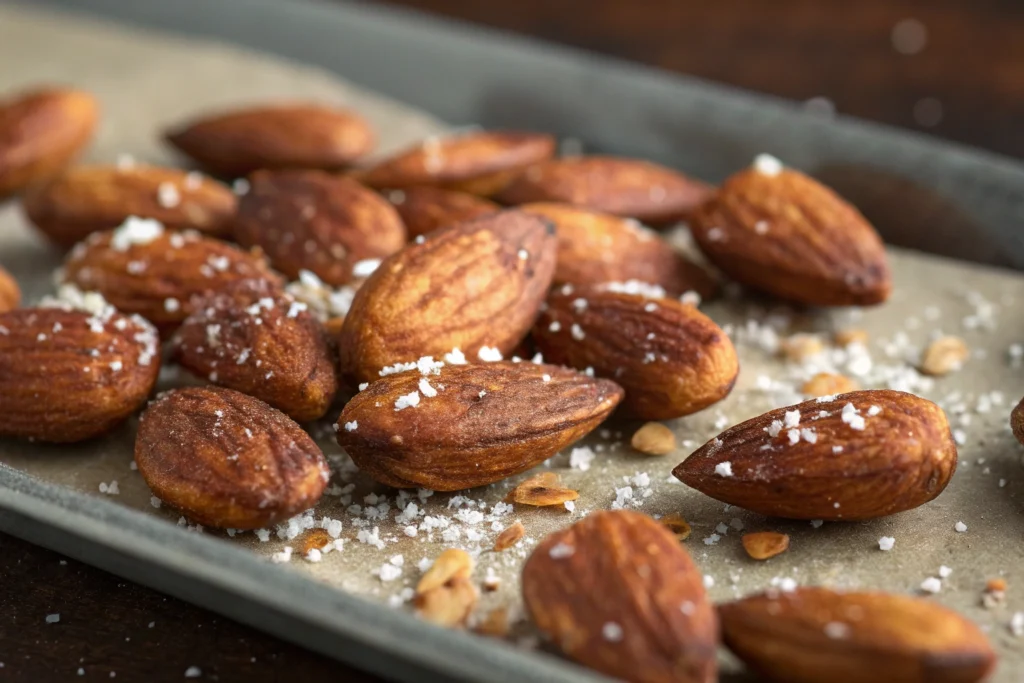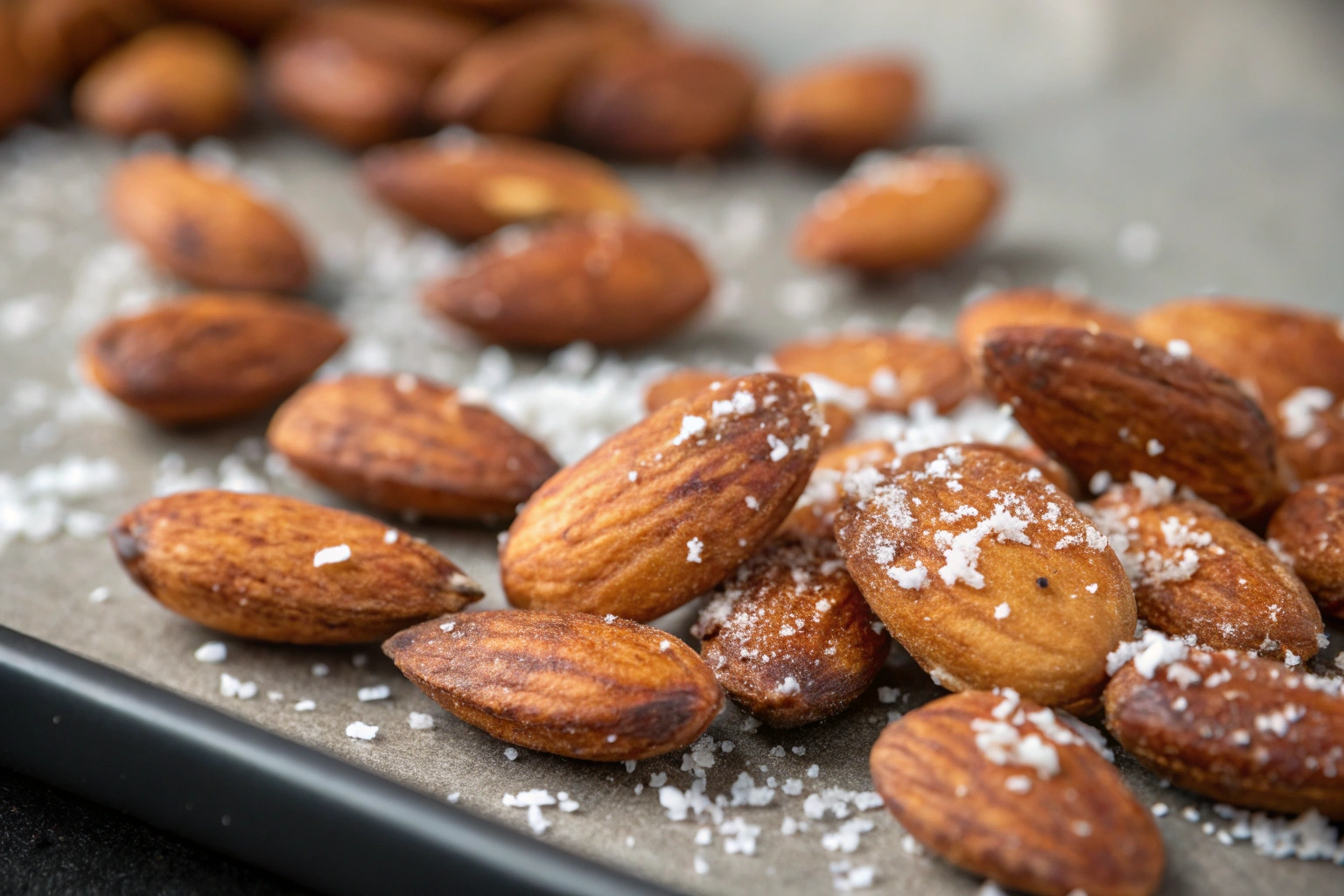Roasting almonds with salt is a simple yet transformative technique that elevates these already delicious nuts to new heights. From enhancing their crunch to enriching their flavor, learning how to roast almonds with salt offers an easy way to enjoy a healthy snack or upgrade your recipes. This guide covers everything, from selecting the best almonds to mastering step-by-step roasting techniques. Whether you’re a beginner or looking to refine your skills, let’s dive in!
Importance of Roasting Almonds

Why Learning How to Roast Almonds with Salt Is Essential
Roasting transforms plain almonds into flavorful delights. The heat caramelizes natural sugars, enhances texture, and brings out their nutty aroma. This process not only adds a delightful crunch but also preserves their nutritional benefits. It’s no wonder roasted almonds are a favorite snack worldwide!
Benefits of Adding Roast Almonds with Salt
Adding salt to almonds isn’t just for taste—it’s a natural way to preserve them while providing electrolytes that boost health. Salted almonds make an excellent snack, balancing savory and crunchy flavors. Plus, they’re perfect for satisfying cravings without resorting to processed snacks.
Understanding Almonds
Types of Almonds Best Suited for How to Roast Almonds with Salt
When deciding which almonds to roast, quality matters. Not all almonds are created equal, and selecting the right variety ensures the best results. Here are two popular choices:
Raw Almonds
Raw almonds are the most common type for roasting. They have a neutral flavor, making them ideal for customization. Look for uniform, unbroken nuts with a smooth surface, as these roast evenly and develop a perfect crunch.
Marcona Almonds
Known as the “queen of almonds,” Marcona almonds are shorter, rounder, and have a buttery flavor. They’re often used in gourmet dishes but are equally delicious when roasted with salt. Their softer texture contrasts nicely with the crispiness roasting provides.
Nutritional Benefits of Almonds
Almonds are nutritional powerhouses. Roasting them doesn’t diminish their benefits; instead, it highlights their natural oils, making them even more appealing.
Nutritional Content (Per 100g):
| Nutrient | Amount |
|---|---|
| Calories | 579 kcal |
| Protein | 21.2 g |
| Fat | 49.9 g |
| Carbohydrates | 21.6 g |
| Fiber | 12.5 g |
| Sodium (if salted) | 120 mg |
Preparation Steps
Selecting Quality Almonds
To achieve the best results when roasting almonds with salt, start with fresh, high-quality almonds. Look for nuts that are uniform in size, free from cracks, and have a firm texture. Always inspect the packaging or buy from trusted sources to ensure they’re free from moisture or mold. Fresh almonds will roast evenly and deliver a superior crunch.
Importance of Soaking Almonds
While soaking almonds before roasting isn’t mandatory, it offers several advantages. Soaking helps remove tannins in the skin, making the almonds less bitter and easier to digest. Moreover, it ensures better absorption of the salt and enhances the overall flavor.
Soaking Methods
- Basic Water Soak: Submerge almonds in a bowl of water with a pinch of salt. Let them sit for 8–12 hours.
- Quick Soak: If you’re short on time, soak the almonds in hot water for 2–3 hours instead.
Benefits of Soaking
- Improves the almond’s texture for even roasting.
- Reduces phytic acid, which can hinder nutrient absorption.
- Allows salt and spices to adhere better during roasting.
By following these preparation steps, you’re laying the foundation for perfectly salted roasted almonds that are both tasty and nutritious.
Roasting Techniques
Oven-Roasting Almonds with Salt

Roasting almonds in the oven is a classic and straightforward method. It ensures even cooking, giving almonds a perfectly crisp texture.
Ingredients Needed
- 2 cups of raw almonds
- 1 tablespoon of olive oil (optional for extra crispiness)
- 1 teaspoon of sea salt
Step-by-Step Process
- Preheat the Oven: Set your oven to 350°F (175°C). Preheating ensures consistent roasting.
- Prepare the Almonds: In a mixing bowl, toss the almonds with olive oil and sprinkle evenly with salt. Skip the oil if you prefer a drier roast.
- Spread on a Tray: Line a baking tray with parchment paper and spread the almonds in a single layer. This prevents uneven cooking.
- Roast and Stir: Place the tray in the oven and roast for 10 minutes. Stir the almonds halfway through to ensure even browning.
- Monitor Closely: Watch the almonds during the last few minutes to avoid over-roasting. They should turn golden and release a nutty aroma.
- Cool and Store: Remove from the oven and let them cool completely. Store in an airtight container for up to two weeks.
Air Fryer Method for Roasting Almonds
For a quicker alternative, try using an air fryer. This method reduces cooking time while achieving similar results.
Equipment and Ingredients
- Air fryer
- 2 cups of raw almonds
- 1 teaspoon of salt
- ½ teaspoon of oil (optional)
Step-by-Step Instructions
- Preheat the Air Fryer: Set it to 325°F (160°C).
- Season the Almonds: Coat the almonds lightly with oil and sprinkle them with salt. Toss to distribute evenly.
- Arrange in the Basket: Spread the almonds in a single layer in the air fryer basket.
- Cook in Batches: To ensure even roasting, avoid overcrowding the basket.
- Air Fry: Cook for 8–10 minutes, shaking the basket halfway through to prevent burning.
- Cool and Store: Once done, transfer the almonds to a plate to cool before storing them in an airtight container.
Flavor Variations
Adding Herbs and Spices
Elevate the flavor of your roasted almonds by experimenting with herbs and spices. Here are some combinations to try:
- Rosemary and Thyme: Toss almonds with olive oil, a teaspoon of dried rosemary, and a pinch of thyme before roasting.
- Cinnamon and Sugar: Mix almonds with a teaspoon of cinnamon, sugar, and a touch of salt for a sweet-savory twist.
Creating Honey-Roasted Almonds
For a caramelized treat, try honey-roasted almonds.
Ingredients and Preparation
- 2 cups of raw almonds
- 2 tablespoons of honey
- 1 teaspoon of oil
- A pinch of salt
Roasting Process
- Preheat Oven: Set the oven to 350°F (175°C).
- Prepare the Mixture: In a bowl, mix honey, oil, and salt until smooth. Add almonds and toss to coat.
- Bake: Spread the almonds on a parchment-lined tray and roast for 15 minutes, stirring halfway.
- Cool and Separate: Let them cool completely before breaking apart any clumps.
Storage and Shelf Life
Proper Storage Techniques for Roasted Almonds
Storing roasted almonds correctly is essential to maintain their crunchiness and flavor. Once cooled, transfer the almonds into an airtight container. Glass jars with tight-fitting lids or BPA-free plastic containers are excellent choices.
For added freshness:
- Store almonds in a cool, dry place, away from direct sunlight or moisture.
- Use vacuum-sealed bags if you plan to store them for an extended period.
Understanding Shelf Life and Freshness
The shelf life of roasted almonds depends on storage conditions.
- Room Temperature: Almonds last for up to two weeks when stored in a cool, dry pantry.
- Refrigeration: Extend their shelf life to 1–2 months by refrigerating them in a sealed container.
- Freezing: For longer storage, freeze roasted almonds for up to six months. Thaw only the portion you need to preserve the rest.
To ensure they’re still fresh, check for signs of rancidity, such as an off smell or a bitter taste. Proper storage ensures your roasted almonds remain a tasty and wholesome snack.
Serving Suggestions
Incorporating Roasted Almonds into Dishes
Roasted almonds are versatile and can elevate a wide variety of dishes. Here are some creative ways to use them:
Salads and Side Dishes
- Add a handful of roasted almonds to green salads for a satisfying crunch.
- Sprinkle crushed almonds over roasted vegetables, like Brussels sprouts or green beans, for added flavor.
Desserts and Snacks
- Incorporate roasted almonds into baked goods such as cookies, brownies, or homemade granola bars.
- Pair them with dried fruits like apricots and cranberries for a healthy trail mix.
Health Considerations
Caloric Content and Portion Control
Although almonds are nutrient-rich, they’re calorie-dense. A serving of 23 almonds (approximately one ounce) contains about 160 calories. Roasting with salt can increase sodium content, so moderation is key. Stick to recommended serving sizes to enjoy them as part of a balanced diet.
Allergies and Dietary Restrictions
For those with nut allergies, almonds may trigger severe reactions. Ensure roasted almonds are clearly labeled if serving them to others. Additionally, check that they’re gluten-free and safe from cross-contamination if catering to individuals with specific dietary restrictions.
Frequently Asked Questions (FAQs)
Can I use salted almonds for roasting?
While it’s possible to roast already salted almonds, the end result might taste overly salty. It’s best to start with raw or unsalted almonds and add salt during the roasting process to control the flavor.
How long should I roast almonds to achieve the perfect crunch?
Typically, almonds roast perfectly in 10–15 minutes at 350°F (175°C). The exact time depends on your oven and the desired level of crunchiness. Always stir the almonds halfway through to ensure even roasting.
Is it necessary to soak almonds before roasting?
Soaking is optional but beneficial. It enhances the texture, removes bitterness from the skin, and allows the salt to adhere better. However, you can achieve delicious results without soaking if you prefer a quicker process.
What type of salt is best for roasting almonds?
Fine sea salt or kosher salt works best for roasting almonds. These types of salt adhere well to the nuts and provide a balanced flavor. Avoid coarse salts, as they may not stick evenly.
How can I ensure even roasting without burning the almonds?
Spread the almonds in a single layer on the tray and stir them halfway through roasting. Keep a close eye on them during the last few minutes, as they can go from perfectly roasted to burnt quickly.
Can I store roasted almonds at room temperature?
Yes, roasted almonds can be stored at room temperature in an airtight container for up to two weeks. Ensure they are completely cool before sealing to prevent moisture buildup.
Conclusion
Summarizing the Art of Roasting Almonds with Salt
Roasting almonds with salt is a simple yet rewarding process that enhances their flavor, texture, and versatility. From selecting the best almonds to mastering various roasting techniques, you now have all the tools to create a nutritious and delicious snack.
Encouragement to Experiment with Flavors
Don’t hesitate to get creative with herbs, spices, and sweeteners to suit your taste. Whether you prefer classic salted almonds or honey-roasted treats, the possibilities are endless. Happy roasting!

